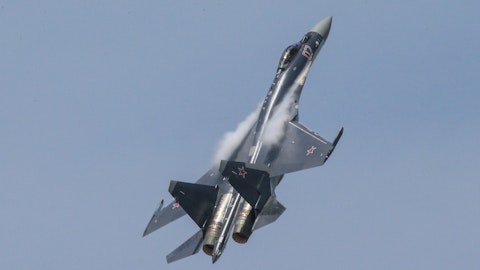So this will be probably the first place where we can value price because my goal is to bring in commercial technology to do that digital, digital data fusion, evaluation, AI application, et cetera. As I said a minute ago, commercial industry is investing 10x what our aerospace and defense industry could invest in these areas, and we need to take advantage of that. The only way they’re going to participate in a material fashion in that industry is value pricing. They’re not going to provide cost information. It’s just not how their industry works. They’re not delivering an airplane that you can add up all the costs that it took to make that airplane and give it to the government, so they can give you the margin on top. So these command and control systems, and they’re real programs, by the way, defensive Blohm is a program like this, AIR6500 is one dimension.
And also something called Joint Fires Network, which will be deployed in the Indo Paycom Command of the U.S. So this is where I think it will start. And then as we look at mission road maps that we’ve established and drawn out inside of Lockheed Martin, and we’re now sharing and have been sharing with the U.S. services and VOD. We’re looking for capability gaps where digital technology can really make a difference, right? So I’ll give you one really quick one. So if we could get a direct feed from an orbiting satellite scanning a wide swath of the Pacific to find ships and actually directly provide that data link and that information to aircraft flying in the area, then those aircraft can vector towards those targets and turn on their radars and get a much more precise location and maybe even a tracking solution to sync the ship if that’s what’s needed.
And so that’s a mission gap, a capability gap that we would have in an antiship mission. And so how do we value price that because that’s basically a data management exercise, which requires what we call 5G.MIL. It requires an artificial intelligence solution within it, and it requires the management of that data at various classifications, which is something not many companies can do besides those in our industry. So we can value price something like that. And I think it’d be a capability gap that would be interesting to the Department of Defense, and they might accept value pricing, but not to take too much time on this topic. But one of the things that we’re really advocating for at Lockheed Martin, and we’ve got some friends of the court trying to work with us on this is, how do we set up an adjacent acquisition process in the Department of Defense to its traditional acquisition process, designed and reconstituted and originated to purchase digital services versus platforms and products, which is what the traditional acquisition system is built to do.
That is a heavy lift. It is very complicated. It’s what I’ve kind of referenced earlier, where you’re literally going to need to act the contrast to do this. But if we want to value price as an industry, bringing commercial partners at scale, I think the government needs to consider and actually go do this with us.
Jay Malave: Let me just circle back, Sheila, on the margins in your question. I’ll use MFC as an example in 2024. When you look at their headwind, the headwind is about 200 basis points of margin compression in the year 2024. The MSC classified program is actually accounted for 230. And so the rest of their business is actually expanding by 30 basis points. And so they’re doing everything we would expect them to do in their core business. In general, across all of Lockheed Martin, the way we’re approaching these headwinds is really threefold. First, we’re just keeping a tight lid on overhead and indirect costs and streamlining that cost structure where the opportunities exist. The second is we’re driving cost reduction in our direct cost base through supply chain optimization, factory productivity and also on 1LMX driven efficiencies.
And then lastly, we talked about a little bit earlier in the call, is just making sure that we’re employing pricing discipline across our bid and proposals. And so those three together will help us drive to a better result in the future and give us confidence that we’ll be able to expand margins even with these headwinds.
Operator: Thank you. Your next question is from the line of Seth Seifman from JPMorgan. Please go ahead.
Seth Seifman: Okay. Thanks very much. And good morning, everyone. Maybe one clarification and one question. Jay, on F-35, at the end of ’24, should we think about there being maybe 120 undelivered aircraft in inventory based on the production rate of 150 plus and the deliveries you’ve told us, that’s the clarification, and that inventory will have to be worked out over the subsequent year or two. And then as far as the question goes, I think you talked about 10 to 20 basis points of segment margin expansion in ’25. If we thought about only one lot exercised on classified missile, that’s probably 25 basis points. The margin in aeronautics seems pretty depressed in ’24. So you think there may be some potential for expansion there.
And you just talked about the efforts that you’re making across the company to support margins. Are there other discrete headwinds that we’re not aware of that wouldn’t allow — that would prevent more than that kind of 10 to 20 basis points that you outlined?
Jay Malave: Yes. Let me start with that question first, and I’ll come back to the F-35. Just on the 2025 margins going forward, yes, it would be essentially one lot versus two. However, you got to take into account the volumes that are in that lot versus the volumes that we’re in these first two lots. And so you really — you think about it from a gross headwind, it doesn’t necessarily change all that much, because you’re — there’s more in there. And so that’s what’s keeping the pressure. There’s not just an automatic lift, because we’re going from two lots to one lot in a subsequent year. On the F-35, I mean, I think the way you’ve talked about it Seth is right, anywhere between 100 to 120 aircraft is in terms of undelivered — against the 156 type of expected delivery rate is the right way to think about it, yes.




